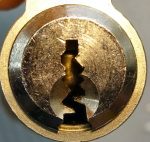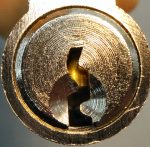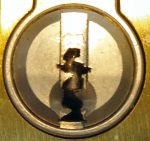Now the fun can REALLY begin! By now you’ve been developing your lock picking skills for several weeks and have probably encountered a few locks that resisted your efforts. It is frustrating. It makes you mad. You want to SMASH that damn lock into small pieces. Yes, been there and done that! Emotions aside, paracentric keyways are a fact of life. Instead of getting mad, embrace the fact that some lock engineer somewhere is doing his job! Unlike our friends at Master Lock that sling together a bunch of parts and call them locks, designers using paracentric designs recognize the threat of lock picking and have been proactive about it. Knowing that, however, doesn’t make them any easier to pick.
You have experience with a variety of different picks, so go through the process and try them all.
Special Tools Needed? Aside from the 3-piece SSDev hook set mentioned earlier, there’s nothing you can buy that’ll help beat these keyways. Persistance, creativity, and just plain stubbornness are MY tools. One of your biggest challenges will be tensioning these beasts. and I often find that I have to make a custom, hand filed tool out of a piece of wire or windshield wiper insert. I do have a set of two serrated tension wrenches that fit nicely into tight spaces. If you have trouble with tensioning, you might want to take a look at ThinkPeterson’s site.
You can’t let yourself get frustrated though. Paracentrics ARE hard locks, and almost all of them contain security pins of some kind. You have experience with a variety of different picks, so go through the process and try them all. If that doesn’t work, you need to get inventive, and that’s where understanding the inner workings can help you.
My first secret: Just because the warding on the face of the lock looks intimidating, it does NOT mean the warding extends any further into the lock. Many times the face warding makes me cringe, but when I slide in a pick I find the pins are 100% accessible.
While there are a lot of paracentrics out there it is impossible to cover them all.
My second secret: The pins HAVE to slide freely in their chambers. You can often insert a deep hook past the warding and chase the pins up into their chambers. This works well when there is plenty of room for you to manipulate a pick, and when the pins are not cut too highly.
My third, and biggest secret: … damn, it was on the tip of my tongue… It was a really good one too…. well, I’ll try to remember and bring it up later.
While there are a lot of paracentrics out there it is impossible to cover them all. They all have similar characteristics but I thought it might be interesting to dig through my own naughty bucket and select the ones that have resisted my best efforts. These should give you some idea of what is out there waiting for you.

This is my nemesis! The Abus TSB-5000 is one of the most paracentric (and frustrating) locks ever designed. My particular lock has some especially radical bitting picked out by Adrian Weber to frustrate me. If you look closely, you’ll notice the pin is actually resting on the warding. Naturally, the first pin is the lowest possible cut, so any pick sliding under it automatically oversets it. This is normal for this lock.
It is possible to attack the pins from the side with a dimple pick, but that will only work if the pins are not cut very high. Naturally, mine are.

We often call this the “Yale Keyway”, but this one has a larger piece of warding at the bottom, preventing us from using the full height of the keyway. It is a GeGe padlock and you can see the pins are resting against the top of the warding at an angle! GeGe is also known for putting a variety of security pins, counter milling and even their own brand of serrated pins into their locks. This one has ALL of that nastiness and I have never been able to overcome it.

Also a GeGe, but this one is a Euro cylinder. I’ve actually opened this one a couple of times but not in a reasonable amount of time. Also, I have NO idea why it opened when it did, surprising me both times. It is full of serrations, countermilling, T-pins and serrated pins.
The keyway is actually pretty reasonable if you use a 0.015″ pick off of the warding on the bottom right. It does grab those sharp edges on the warding, giving a lot of false feedback, but it does work.

This is on a Burg Wachter Diamond padlock. Others have opened these on YouTube but I’ve never been able to open this one. It does have some nasty bitting picked out by Adrian Weber, but it should STILL be possible. It has seven pins and I swear they are all spools and I feel I’ve picked all of them, yet no open. When Adrian sent this lock it was brand new, but today it is quite tarnished from the years of holding it in my sweaty hands.

This German BKS looks like a Yale with the tail going the wrong way. The warding on this one is REAL, as I discovered after picking for several hours. I’ve come CLOSE to picking this one but only after buying some 0.010″ and 0.012″ material and making some custom picks for it. As it turned out, the 0.010″ is too thin and bends before I’m able to set the pins (all security pins I believe). The 0.012″ works well on the first three pins, but by the time I get to pin 4 it flexes too much to put pressure on the pin. 0.015″ is too wide. When I get some money saved up maybe using a thickness in between those will give me the magic I need to let this one “graduate” from the naughty bucket.

This is the typical Abus Euro cylinder version of the Yale keyway. The warding sticks out into the keyway just a bit too far to allow us to use a pick from the bottom. Instead, you have to lever off of the ledge on the right, about 1/2 of the way up the keyway. The warding does go all the way through the core, unfortunately.
I’ve picked a LOT of Abus’ with this keyway, but this one has really nasty bitting (hi-lo-hi-lo) at max cuts, so I simply can’t fit a hook with enough lift into the keyway without oversetting the low cut pins. If I could find some REALLY strong, thin wire… like…MAGIC wire…

This is one of the German made Wilka’s proprietary keyways. The warding goes all the way through the core and this lock has some pretty extreme bitting. There is enough space to fit the deep SSDev hook into the keyway and lever off the warding on the left side. The pick does get snagged up and offers a lot of false feedback, but I have never been able to get this one picked open. The first 3-4 pins are not too difficult, but when you reach for the rear-most two pins I seem to fail every time. Not a single open in five years of trying…
God, I wish I had a life…
While you may never face keyways as bad as these I thought it important to share them and make you aware that this type of technology is waiting for you out there. Paracentric keyways are just one tool that lock designers have to use against us and I urge you to find some practice locks, grind out your own tools, and be prepared for the day that you face one of them.
Are you ready to learn about serrated pins? Let’s DO it! LP401, here we come!